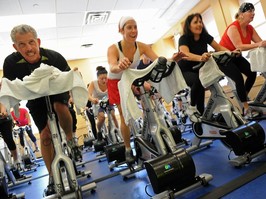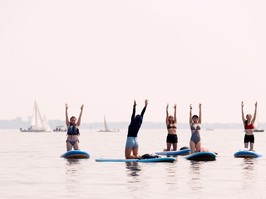chilly weather typically means it’s time to hunker down inside. but many canadians are exercising outside this winter as gyms and fitness studios shut down amid the pandemic.“there are ways to stay active…in spite of the cold,” says kaori noguchi, a personal trainer and owner of daily flex personal fitness. “there is a benefit to spending a few minutes outdoors, just [to] get some sun and get your muscles and body moving.”exercise is important to maintaining physical and
mental health throughout the winter. it has also been
linked to therapeutic effects for seasonal affective disorder. while some have turned to
walking their partners like pets, we asked personal trainers to offer tips for exercising outside safely and effectively during the colder months.
pick the right gear – and whatever you do, avoid cottonlayering the right gear is important to striking a balance between staying warm enough without overheating, says alicia malcolm-anderson, a
former professional athlete and yoga instructor with a background in physio therapy and sport and exercise medicine. be ready to adjust what you’re wearing throughout your workout to stay at a comfortable temperature – extra layers for the warm-up or breaks in your routine that can easily come off when you’re picking up the pace.“you want to dress not just warmly, but dry,” says noguchi. anything containing cotton or a cotton-blend isn’t the best option because it
absorbs and holds onto moisture (like sweat). when the damp fabric is left in the cold air, this can cool you down considerably faster – dangerous when temperature hits the negatives.noguchi recommends looking out for clothing that claims to be
moisture wicking. synthetics like polyester or nylon fit the bill. if you’re looking for something more natural, many outdoorsy types swear by merino wool, which is moisture wicking, but much softer than infamously scratchy regular wool.“you also have to keep in mind about the cold air that you are breathing,” says noguchi. if the weather really starts to get cold, she recommends using a thin layer of fabric across your nose and mouth. this piece of fabric – like a scarf or a mask – will be warmed up when you exhale and work to slightly warm the temperature of the air you inhale.if you do choose to wear a layer over your nose and mouth while working out be sure that you are able to easily breath with it on and can take it off quickly if you need to.the cold will also
drain batteries, so make sure your phone is well charged before you go out and keep it in an interior pocket close to your body where it will stay warm for emergencies.
plan out your activities with the cold in mindeven with the best gear, being outside in the winter is going to be differen than getting active in summer. if you’re new to being outside in colder temperatures for long periods of time, malcom-anderson recommends that you ease yourself into it and have a plan to get yourself home that takes the cold into account.“if somebody’s newer to exercise and just starting in the winter, then maybe they start with shorter trips, tasting it out, rather than maybe going out in the bushes,” says malcolm-anderson. “i think also depending on fitness levels, some people might calculate that they’re going to be out for a certain period of time, but then the body might start to…ache and so it takes longer. [you have to] be able to walk briskly back home.”weather can also change quickly in the winter months. temperatures can drop suddenly – especially as the sun starts to set – and snowfall can pick up suddenly. noguchi recommends that you stay closer to home than you usually would. try running laps around your neighbourhood rather than running along a trail or pick a field that you can easily walk to and from.
alter your summertime activities or pick activities designed for winterdepending on what sport you’re trying out, footwear might also be a concern. winter sports like ice skating or snowshoeing require footwear that’s built to withstand the cold and snow. if you want to keep up summertime activities, like running, make sure your feet are outfitted properly.“[the] majority of running shoes are designed in such a way that it’s supposed to keep your feet cool rather than warm,” says noguchi. “consider wearing warmer socks.”slippery conditions are also a concern when running or walking. running shoes designed to grip the road and trails in summer months won’t get the same sort of traction on snow. depending on the make, rubber can also
become hard and brittle in the cold, making even the driest path potentially treacherous. there’s also some concern that if your running shoes harden up, it can put more pressure on your feet as you run, which might lead to injuries down the road.noguchi advises that runners go slow at first to make sure they have enough traction and their shoes are comfortable before picking up the pace. attachments
are also available for running shoes that will help keep a grip on cold trails.
 5 minute read
5 minute read










